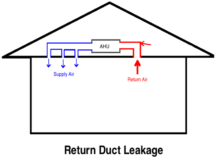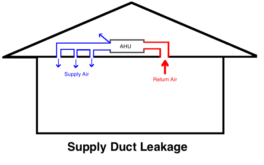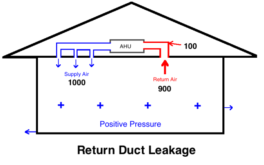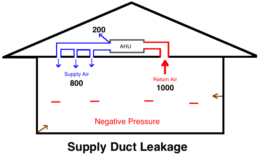
As a kid, did you ever have your mom or dad get mad at you for leaving the door open or constantly running in and out? You may have heard this phrase: “What are you trying to do? Air condition the whole neighborhood? You’re letting all the air out!” Truth be told, many of us are doing that without even knowing it.
Last week, we covered airflow balance. Airflow balance issues are caused by a number of things; most commonly issues with the ductwork or return register. This week, we are going to cover a specific issue in ductwork: Duct Leakage. Duct Leakage is very similar to the air leakage that happens with windows and doors in that it makes for higher energy and heating/cooling costs. In fact, the Department of Energy lists both air leakage and duct leakage among the top 3 home energy wasters. Recent research from the Lawrence Berkley National Lab found that duct systems leak 10% of supply air (air being blown out through your vents) and 12% of return air (air being drawn out and recycled through your air handler and re-cooled or warmed to be pumped back into your home).
So, what is the difference in the 2? Air leakage is just air seeping out of your home. Duct leakage can actually cause even worse air leakage and affect your indoor air quality.
How exactly does duct leakage affect your air quality and cost you money? Last week, we briefly discussed how a typical split home HVAC system works (but if you missed it, here’s the link: https://www.boilingspringshvac.com/blog/airflow-balancing-tips-and-tricks/). In short, an HVAC system doesn’t continually pump in air without taking some back out, or otherwise it creates an air pressure buildup. That is why your system has a return register (where your air filter goes). The register sucks air out and runs it back over the coils in your air handler, reheating or re-refrigerating the air to be pumped back out through your supply ducts and out the vents into your home. Depending on the size of your system, it is supposed to equally pump in and draw out a set amount of cubic feet per minute (CFM) of air. If you have a leak in your ductwork, there is an imbalance in that CFM of air circulating, and thus the pressures will be uneven.




For example, say you have a system that circulates 1,000 CFM of air with a 100 CPM leak in the return ductwork. The supply ducts pump out the 1,000 CPM they are supposed to, but the return only draws out 900 CFM of air from your house, meaning the pressure will be positive. With more air pressure buildup, the excess air has to find some means of escaping. Thus, it gets forced out from wherever it can find, resulting in more leakage through your doors, windows, etc. This will make for higher heating and cooling costs since the system will need to run longer to make up for the amount of air seeping out. Not only that, but if your return is only drawing in 900 CFM, it takes 100 CFM from an unconditioned space (i.e. a crawl space or your attic). This can be especially hazardous to your air quality, as air drawn in from crawl spaces and attics will bring with it moisture, mold spores, dust, insulation fibers, etc.
On the flip side, if your supply ducts are leaking, less air is blowing into your home, meaning it does not heat or cool as efficiently. The Return register is drawing out more air than is getting blown in. Thus, the system runs longer and works harder to get the necessary volume of air through your vents and into your home. This shortens the lifespan of equipment and drives your energy costs up.
Suspect you might have a leak in your ducts or just looking to make sure you don’t? Here are the common ways that professionals test for it (which we can do for you!) :
Duct leakage is most commonly caused by a disconnected duct joint and is repaired by sealing the joint with either spray on or brush-on sealant and caulking.
Energy and money-saving tips:
We hope, as always that this post has been not only informative but also helpful. If you have any questions about ductwork or would like to know more about our ductwork services, please give us a call today at (864)-578-7575!